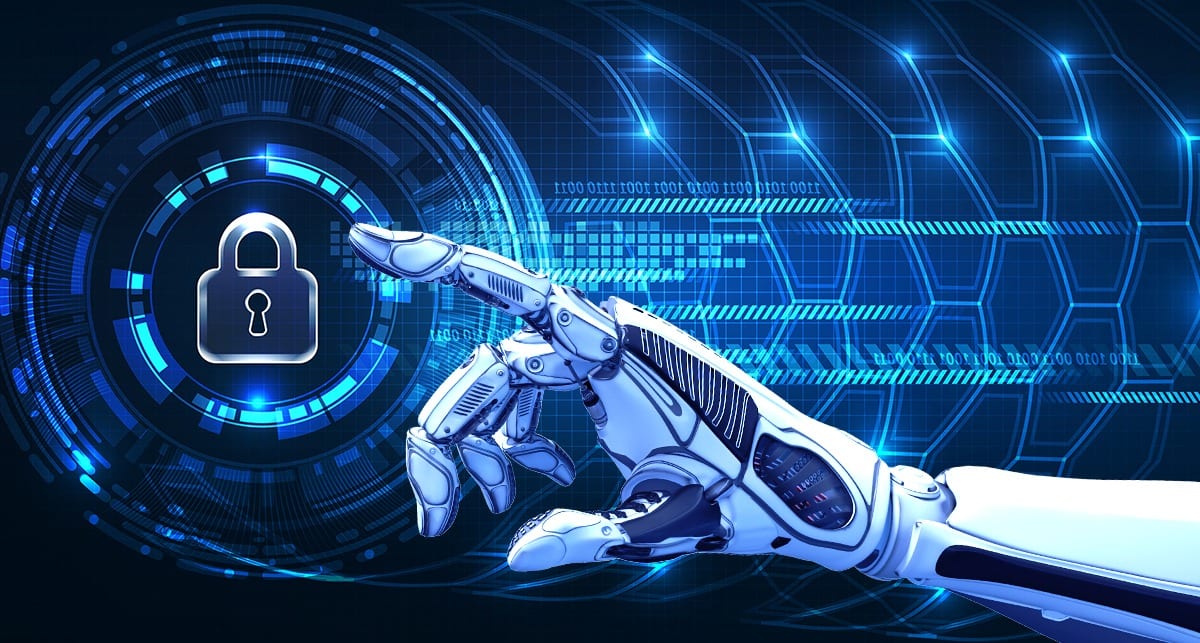Benefits of AI in Cybersecurity
Updated September 2023
Introduction:
One of the most impactful ways AI revolutionises cybersecurity is through machine learning-based threat detection and prevention. Machine learning algorithms can analyze vast amounts of data to recognize patterns and behaviours that may indicate a cyberattack. Training these algorithms on historical cyber threat indicators gives them an “instinct” to detect even novel threats they’ve never seen before based on similarities to known malicious patterns. This approach allows AI systems to identify threats at machine autonomously speeds far exceeding human analysts.
AI is also improving threat response times. Once a machine learning model detects an anomaly or threat, it can immediately trigger automated response and remediation measures. This helps contain breaches and limit damage faster than waiting for human intervention. Additionally, AI is augmenting human cybersecurity teams by sifting through massive logs and alerts to surface the most critical incidents for analysts to prioritize. This helps overburdened teams focus their limited time on the most pressing security matters. As machine learning algorithms learn from ever-growing data, their threat detection capabilities will become more precise and preemptive. Combined with automated response, AI is revolutionizing how organizations can stay ahead of increasingly sophisticated cyberattacks.
Enhanced Threat Detection and Prevention:
AI-powered cybersecurity systems have revolutionized threat detection and prevention by leveraging advanced machine learning algorithms. These systems analyse vast amounts of data in real-time, enabling them to detect and mitigate cyber threats more effectively than traditional rule-based systems.
One of the critical advantages of AI-powered cybersecurity is its ability to learn and adapt to new attack patterns continuously. Unlike static rule-based systems, AI systems can dynamically update their knowledge base and identify emerging threats. These systems can detect anomalies and patterns that may indicate a potential cyber attack by analysing network traffic, user behaviour, and system logs. This proactive approach allows organizations to take immediate action to prevent breaches and minimize the impact of cyber attacks.
Furthermore, AI-powered cybersecurity systems can provide real-time threat intelligence, allowing organizations to stay one step ahead of cybercriminals. By analyzing global threat data and sharing information across networks, these systems can identify and block malicious activities before they reach their targets. This collaborative approach enhances the overall security posture and strengthens the resilience of organizations against evolving cyber threats.
AI-powered cybersecurity systems offer enhanced threat detection and prevention capabilities by leveraging machine learning algorithms. Their ability to continuously learn, adapt, and analyze vast amounts of data in real-time enables them to identify and mitigate both known and unknown threats. By adopting these advanced systems, organizations can significantly improve their cybersecurity defences and protect their valuable assets from malicious actors.
Automated Incident Response:
In the event of a cyber attack, AI-powered cybersecurity systems can automate incident response processes, enabling organizations to respond swiftly and effectively. AI algorithms can analyze and prioritize security alerts, allowing security teams to focus on critical threats. This automation saves time and reduces the risk of human error, which can be costly in cybersecurity.
Furthermore, AI systems can autonomously execute predefined response actions, such as isolating compromised systems, blocking malicious IP addresses, or quarantining suspicious files. This automated incident response capability ensures a rapid and coordinated response, minimizing the potential damage caused by cyber-attacks.
Moreover, AI-powered incident response systems continuously learn and adapt to new threats and attack patterns. By leveraging machine learning algorithms, these systems can detect and respond to emerging threats in real time. They can analyze vast amounts of data, including network traffic, system logs, and user behaviour, to identify anomalies and potential security breaches.
Additionally, AI-powered incident response systems can integrate with other security tools and technologies, creating a unified defense strategy. They can share threat intelligence and collaborate with other security solutions, such as firewalls, intrusion detection systems, and threat intelligence platforms. This integration enhances the overall security posture of an organization and enables a more proactive approach to cybersecurity.
AI offers significant advantages in combating cyber threats. It streamlines the response process, reduces human error, adapts to new threats, and integrates with existing security infrastructure. By leveraging AI technology, organizations can enhance their cybersecurity capabilities and better protect their digital assets.
Advanced Behavioral Analysis:
AI algorithms excel at analyzing and understanding complex patterns of behaviour. In cybersecurity, this capability is invaluable for identifying and mitigating insider threats and advanced persistent threats (APTs). By monitoring user behaviour and system activities, AI systems can establish baseline profiles for normal behaviour and quickly identify deviations that may indicate malicious intent.
For example, if an employee suddenly starts accessing sensitive files outside of their regular working hours or attempts to exfiltrate data, an AI-powered system can raise an alert and initiate appropriate actions. This proactive approach to insider threat detection helps organizations prevent data breaches and protect their critical assets.
Advanced behavioural analysis techniques go beyond simply flagging anomalous activities. Sophisticated AI models are able to understand the intent and motivations behind a user’s actions by analyzing patterns in their behaviour over time. For instance, an employee who gradually expands their access to restricted systems and data but remains otherwise productive may indicate the early stages of an insider threat. Without advanced behavioural analysis, such a threat could go unnoticed for months.
AI can also detect subtle language changes that correlate with increased risk by applying natural language processing to analyze written communications like emails, chat logs, or documentation edits. An employee who suddenly becomes evasive or secretive in their written correspondence may be initially planning a data breach or sabotage attempt. Cross-referencing linguistic flags with anomalous access patterns and other risk factors allows advanced behavioural analysis through AI to accurately identify insider dangers long before damage occurs. This helps security teams intervene proactively to avert crises and minimize organizational harm.
Real-time Threat Intelligence:
key benefits of integrating real-time threat intelligence with AI systems. Here are a few key highlights from real-time threat intelligence feeds that may help organizations enhance their cybersecurity posture:
– Security vendors like Cisco Talos and Microsoft detect an average of 250,000 new malware samples daily. By monitoring these sources, AI systems can continuously update signatures and detection models to identify new variants.
– The U.S. Cybersecurity and Infrastructure Security Agency (CISA) publishes alerts on vulnerabilities and exploits in active campaigns. Integrating this intelligence allows AI to flag systems that may be at risk and in need of patching.
– Open-source intelligence (OSINT) communities like MalwareHunterTeam and Swascan share IP addresses and domains known to host phishing pages or command and control servers. AI can use this to block malicious connections and filter suspicious emails in real-time.
– Threat intelligence platforms aggregate data from all these sources into structured formats to power AI/ML algorithms. Models can then identify patterns to uncover hidden relationships between disparate threats.
Real-time threat intelligence is certainly a powerful way for AI cybersecurity systems to dynamically adapt defences based on the latest adversary techniques. This helps level the playing field against sophisticated attackers.
Conclusion:
In conclusion, integrating Artificial Intelligence (AI) into cybersecurity heralds a new era of defence against evolving cyber threats. AI’s machine learning capabilities enhance threat detection, enabling the identification of known and novel threats. Automated incident response saves time and reduces the risk of human error, while AI’s adaptability ensures it stays ahead of emerging threats.
Advanced behavioural analysis empowers organizations to detect insider and APT threats, safeguarding critical assets proactively. Furthermore, incorporating real-time threat intelligence feeds into AI systems allows for agile defence strategies against ever-evolving adversaries. AI is the cornerstone of resilient and effective cybersecurity in an age of escalating cyber threats.
Other Articles of Interest

Rethinking Education: Embracing AI and its Implications

Yen Crash: Approaching the Bottom or Further Decline Ahead?
Puppet Master: China Vs USA: Who Is The Spider

Decoding the Enigma: What Are Gold Bugs

Long-Term Gold Targets: Exploring the Path to the Moon
Capitalizing on the Oil to Gold Ratio: An Ideal Time to Invest in Oil

Trading Chart Patterns Cheat Sheet: Mastering the Key to Success

Abu Bakr al-Baghdadi: The Rise and Fall of the ISIS Leader
Gold bullion bars prices: Trend Projections

The Poor Get Poorer And The Rich Get Richer: Deepening Inequality

The Kurds: Defying Extremism and Paving the Path to Peace in Syria

Volatile Markets: Conquer Market Turbulence and Thrive
Is Religion Dying: Shaping Beliefs with New Discoveries

Exploring the Depths of the Unconscious Mind

Day Late and a Dollar Short: Lessons in Timing and Consequence



